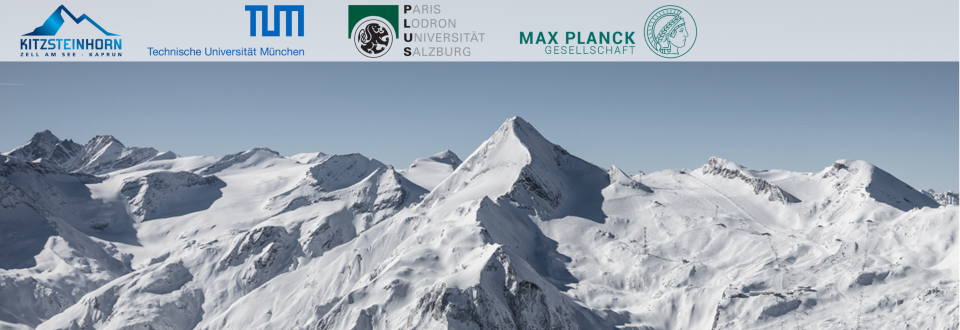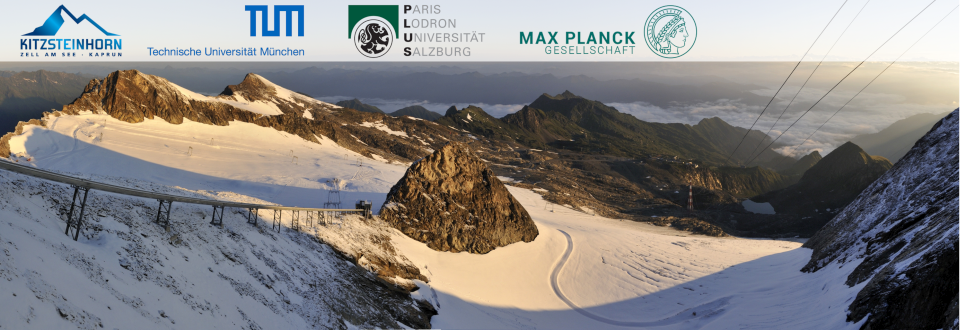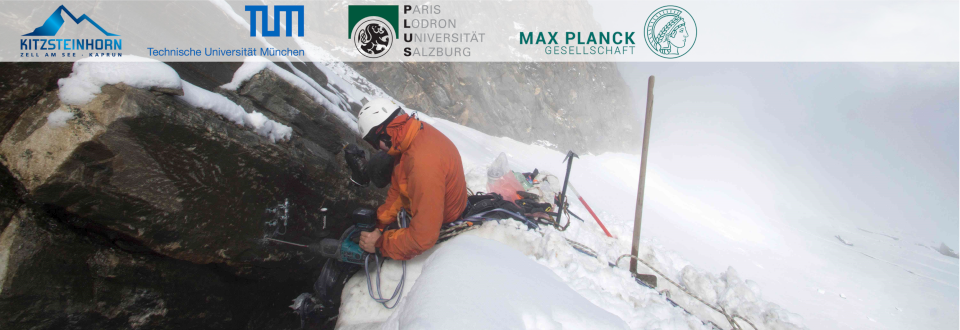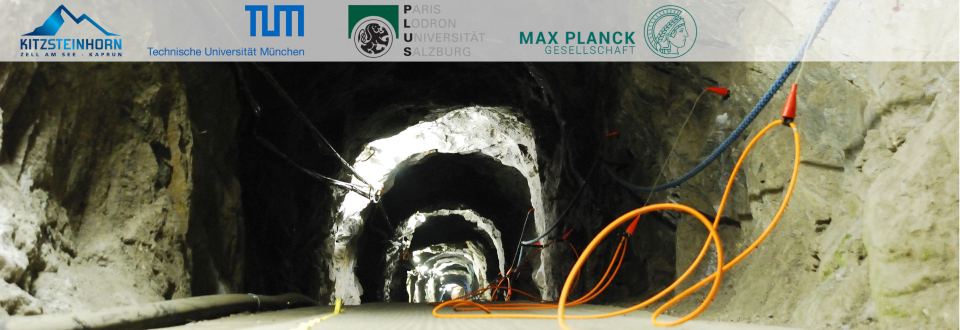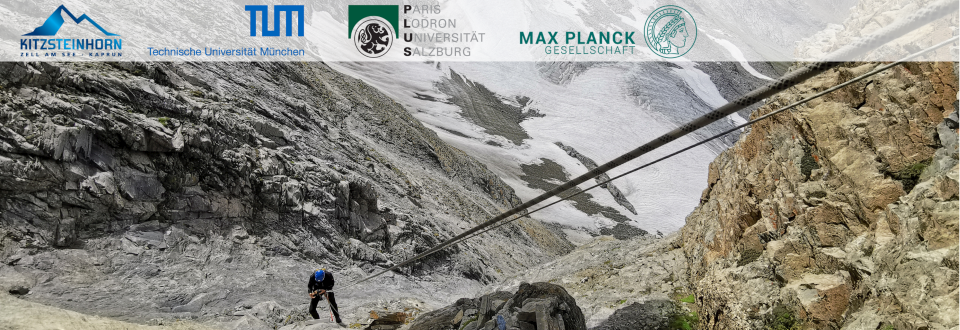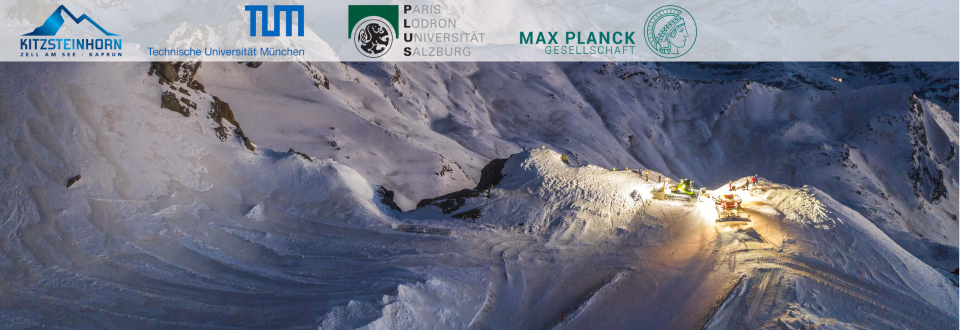AUSGEWÄHLTE REFERENZEN
2025
Mit Drohnen-Einsatz in Salzburg: Forscher zeigen Gletscherverluste auf. Salzburger Nachrichten, 06.03.2025
Kitzsteinhorn verliert jedes Jahr bis zu einem Meter Eis. Salzburg 24, 06.03.2025
Forscher zeigen mit Drohne und Co Gletscherverluste auf. Puls 24, 06.03.2025
Forscher zeigen mit Drohne und Co Gletscherverluste auf. News, 06.03.2025
Forscher zeigen mit Drohne und Co Gletscherverluste auf. Austria Presse Agentur, 06.03.2025
Sicher Skifahren trotz Klimawandel. Ski-Magazin, März/April 2025, Seite 70-73.
Permafrost und Gletscher den Puls messen am Kitzsteinhorn. Salzburger Nachrichten, 25.02.2025
Am Kitzsteinhorn ist der Klimawandel sichtbar. Salzburger Nachrichten, 22.02.2025
Experten besorgt über tauenden Permafrost. salzurg.orf.at, 22.02.2025
Klima-Gipfel in Zell am See, Salzburg-Heute Beitrag, 22.02.2025
2024
Hartmeyer I. & Otto J.-C. (2024): Rockfall, glacier recession, and permafrost degradation: long-term monitoring of climate change impacts at the Open-Air-Lab Kitzsteinhorn, Hohe Tauern. DEUQUA Special Publications, 5, 3–12, https://doi.org/10.5194/deuquasp-5-3-2024, 2024 (09.09.2024).
Delleske, R., Siebenbrunner, A., Keuschnig, M. (2024): Airborne snow profiling. Large-scale UAS Snowpack Stratigraphy using Ground-Penetrating Radar. Airlabs Future Conference 2024, 13.06.2024, Riegersburg, Austria.
Hartmeyer I., Keuschnig M., Krautblatter M., Otto J.-C., Valentin G. (2024): Permafrost thaw and its effects on the occurrence of natural hazards: Three long-term case studies from the Hohe Tauern Range. In: Schneider et al. (Eds.): Interpraevent 2024, Conference Proceedings, ISBN 978-3-901164-32-3.
Offer, M., Weber, S., Keuschnig,M., Hartmeyer, I., Krautblatter, M. (2024): Water flow in fractured bedrock permafrost: a potential hazard for high alpine infrastructure. Proceedings IP 2024. 732-735.
Hartmeyer, I., Keuschnig, M., Krautblatter M. (2024): Permafrost degradation in the Eastern Alps: Insights from three long-term monitoring sites in the Hohe Tauern Range, Salzburg. Austria. Proceedings 14th D-A-CH Permafrost Conference 2024. page 8
Offer, M., Keuschnig, M., Weber S., Hartmeyer I., Krautblatter, M. (2024): Hydrothermal processes in steep rock wall permafrost. Proceedings 14th D-A-CH Permafrost Conference 2024. page 9
Stockton, E.J., & Burn, C.R. (eds.) (2024): Country Reports 2022-2023: Reports from the Adhering Bodies of the International Permafrost Association. International Permafrost Association (IPA). DOI: 10.52381/ CR.2022-2023.
Keuschnig, M. (2024): Forschungsstation Kitzsteinhorn. Grundlagen für eine erfolgreiche Klimawandelanpassung im hochalpinen Raum. Vortrag Geotage Bischofshofen. 08./09.03.2024
Siebenbrunner A. (2024): Schneedeckenstratigraphie aus der Luft. 50.000 „Schneeprofile“ in 20 Minuten mithilfe von Drohnen und GPR. Welt der Wissenschaft. 04.03.2024
2023
Siebenbrunner, A., Delleske, R., Koler, A., Keuschnig, M. (2023). Exploring the capabilities of UAV-based GPR for detecting weak layers in snowpacks. 1-5. 10.3997/2214-4609.2023101241.
Siebenbrunner, A., Delleske, R., Keuschnig, M. (2023). UAV-borne GPR Snowpack Stratigraphy. Conference: ISSW 2023
Offer, M., Keuschnig, M., Weber, S., Hartmeyer, I., and Krautblatter, M. (2023): Identification of fluid flow in permafrost bedrock: first evidence from long-term measurements. World Landslide Forum 2023, Florecnce, Italy, 14–17 November 2023.
Kitzsteinhorn - Berg zwischen den Welten. Österreich Bild am Feiertag (TV-Sendung), ORF2, 01.11.2023 (18:25).
Erdkugel und ihre Oberfläche verändern sich. ORF.at (ORF Topos), 30.09.2023.
Permafrost thawing in the Alps: New insights on risks, monitoring & hazard management. Webinar of the Alpine Climate Board (Alpenkonvention). 28.09.2023.
Hartmeyer I., Keuschnig M. (2023): Open-Air-Lab Kitzsteinhorn: A decade of glacier and permafrost monitoring in the Hohe Tauern Range. Oral presentation at „25 Jahre International Permafrost Association (IPA) Austria: 1998-2023“, Mallnitz, 28.09.2023.
Hartmeyer I., Keuschnig M. (2023): Long-term anchor load monitoring reveals changing stress regimes in warming permafrost rockwalls. Oral presentation at „25 Jahre International Permafrost Association (IPA) Austria: 1998-2023“, Mallnitz, 28.09.2023.
Offer M., Keuschnig M., Scandroglio R., Stockinger G., Krautblatter M. (2023): Geophysikalische Untersuchungen von instabilen Permafrost-Felswänden an Standorten mit hochalpiner Infrastruktur. Fachsektionstagung Geotechnik, Würzburg, Germany, 12-13. September 2023.
Permafrostmonitoring am Kitzsteinhorn. ORF.at, 10.09.2023.
Guten Morgen Österreich, TV show, ORF 2, 6:30-9:00, 26.07.2023.
Frostiges Herz - Permafrost-Forschungsprojekt Open-Air-Lab-Kitzsteinhorn. Geschichten der Nachhaltigkeit, digitales Magazin der Gletscherbahnen Kaprun AG, 07.07.2023.
Abtauender Permafrost löst Felsstürze aus. ORF.at, 21.06.2023.
Offer, M., Keuschnig, M., Scandroglio, R., and Krautblatter, M. (2023): Combining ERT, SRT and GPR to decipher permafrost and fluid flow in fractures. European Conference on Permafrost 2023, Puigcerdà, Spain, 18–22 June 2023.
Touren im Hochgebirge werden riskanter. ORF.at, 18.06.2023.
Das Kitzsteinhorn - Mehr als ein Berg. TV-Dokumentation aus der Reihe "Bergwelten", Servus TV, 46 Minuten, 03.04.2023.
Neuhold T. (2023): Auswirkungen von Temperaturschwankungen auf die Dynamik von Felsklüften in einer kürzlich eisfreien Karrückwand (Hohe Tauern, Ostalpen). Masterarbeit, Paris-Lodron-Universität Salzburg, März 2023, 53 Seiten.
Felix Neureuther - Skifahren trotz Klimawandel? TV-Dokumentation, ARD, BR, 44 Minuten, 20.01.2023.
2022
Gletscherskigebiete werden zu Höhenskigebieten umgewandelt. Der Standard, 18.10.2022.
Hartmeyer I., Keuschnig M. (2022): Focus, Funding and Future of the Open-Air-Lab Kitzsteinhorn Hohe Tauern Range, Austria. Vortrag im Rahmen der International Mountain Conference, Innsbruck, 13.09.2022.
Hartmeyer I., Keuschnig M., Krautblatter M. (2022): Open-Air-Lab Kitzsteinhorn: Permafrost-Monitoring & Klimawandelanpassung in den Hohen Tauern. Vortrag im Rahmen des AK Permafrost der Deutschen Gesellschaft für Polarforschung, 06.05.2022.
Steinschlag, Bergstürze und Murgänge – Klimawandel in den Alpen. SWR2 Wissen, 25.01.2022.
2021
Hartmeyer I., Keuschnig M., Delleske R., Otto J.-C., Lang A., Valentin G., Krautblatter M. (2021): High-alpine rockfall activity in a warming climate - Insights from long term rockwall monitoring at the Hohe Tauern Range, Austria. Vortrag im Rahmen des Mitteleuropäischen Geomorphologie Meetings (MGM 2021), München, 06.11.2021.
Wir erforschen wie Gletscher und Gebirge atmen. Kleine Zeitung, 26.10.2021, S. 18-19.
Kitzsteinhorn: Freiluftlabor liefert die Daten für die Zukunft. Salzburger Nachrichten, 06.10.2021.
Rettung für die Alpen. TV-Dokumentation, 50 Minuten, National Geographic, 20.09.2021.
Hartmeyer I., Keuschnig M., Delleske R., Krautblatter M., Lang A., Otto J.-C., Schrott L. (2021): Neun Jahre Felswand-Monitoring
Kitzsteinhorn (2011-2020): Gletscherrückgang verstärkt hochalpine Steinschlagaktivität. Vortrag im Rahmen des Klimatags 2022 (Online-Konferenz), 12.04.2021.
2020
Hartmeyer I., Delleske R., Keuschnig M., Krautblatter M., Lang A., Schrott L., and Otto J.-C.: Current glacier recession causes significant rockfall increase: the immediate paraglacial response of deglaciating cirque walls. Earth Surface Dynamics, 8, 729–751, https://doi.org/10.5194/esurf-8-729-2020.
Hartmeyer I., Keuschnig M., Delleske R., Krautblatter M., Lang A., Schrott L., Prasicek G., Otto J.-C. (2020): A 6-year lidar survey reveals enhanced rockwall retreat and modified rockfall magnitudes/frequencies in deglaciating cirques. Earth Surface Dynamics, 8, 753–768, https://doi.org/10.5194/esurf-8-753-2020.
2019
Helfricht K., Hartmeyer I., Keuschnig M., Krautblatter M., Leith K., Otto J.-C. (2019): Microclimate and temperature distribution inside a randkluft system – first observations and insights. Posterpräsentation EMS Annual Meeting 2019, Copenhagen, Denmark, Vol. 16, EMS2019-90.
2018
Otto J.-C., Hartmeyer I., Keuschnig M. (2018): Naturgefahren in alpinen Permafrostregionen und Permafrostmonitoring. Geographische Rundschau 11-2018, 30-35, Braunschweig, Deutschland.
Ewald A., Hartmeyer I., Lang A., Otto J.-C. (2018): Fracture Dynamics and Rock Slope Stability in Deglaciating Headwalls. Posterpräsentation bei der EGU General Assembly 2018, Geophysical Research Abstracts, Vol. 20, EGU2018-6383, 2018.
Hartmeyer I., Keuschnig M., Delleske R., Plaesken R. (2018): OPAL—The Open-Air-Lab Kitzsteinhorn: Monitoring high-alpine rockfall and permafrost in a warming climate. Posterpräsentation bei der Jahrestagung des AK Hochgebirge, 2.-4. Februar 2018, Innsbruck.
2017
Hartmeyer I., Keuschnig M., Fegerl L., Valentin G., Helfricht K., Otto J.-C. (2017): Long-term monitoring of climate-sensitive cirques in the Hohe Tauern range. Vortrag beim 6th International Symposium for Research in Protected Areas 2017, Salzburg, Österreich.
Keuschnig M. & Hartmeyer I. (2017): The Open Air Lab Kitzsteinhorn (OpAL) – Open Innovation in High Altitude. Posterpräsentation beim 6th International Symposium for Research in Protected Areas 2017, Salzburg, Österreich.
2016
Keuschnig, M., Krautblatter, M., Hartmeyer, I., Fuss, C., and Schrott, L. (2016) Automated Electrical Resistivity Tomography Testing for Early Warning in Unstable Permafrost Rock Walls Around Alpine Infrastructure. Permafrost and Periglacial Processes, doi: 10.1002/ppp.1916.
Hartmeyer I., Keuschnig M., Delleske R., Schrott L. (2016): Rockfall in permafrost-affected Cirque Walls: New Insights on Spatial Variability and Potential Causes derived from a 4-year LiDAR monitoring campaign, Kitzsteinhorn, Austria. Vortrag auf der 11th International Conference on Permafrost, 20-24. Juni 2016, Potsdam, Deutschland.
Forschungsobjekt Permafrost. In: 'Salzburg. Der Aufstieg zum Winter-Eldorado', Magazin der Salzburger Nachrichten (S. 20-21) (21.11.2016.).
Planet Wissen - Gletscherschmelze, Klimawandel im Hochgebirge. ARD Alpha (21.10.2016).
Gletscherschmelze – Klimawandel im Hochgebirge. ARD Alpha & Bayerischer Rundfunk (02.08.2016).
Permafrost in Österreich - Ein erster nationaler Kurzbericht. Bergauf - Mitgliedermagazin des ÖAV (03/2016, 50-53).
2015
Keuschnig, M., I. Hartmeyer, G. Höfer-Öllinger, A. Schober, M. Krautblatter, Schrott L. (2015): Permafrost-Related Mass Movements: Implications from a Rock Slide at the Kitzsteinhorn, Austria. In book: Engineering Geology for Society and Territory - Volume 1, Chapter: 48, Publisher: Springer International Publishing, Editors: Giorgio Lollino, Andrea Manconi, John Clague, Wei Shan, Marta Chiarle, pp.255-259.
Höfer-Öllinger, G., M. Keuschnig, M. Krautblatter, Schober A. (2015): Climate Change Impacts on High Alpine Infrastructures: An Example from the Kitzsteinhorn (3200 m), Salzburg, Austria. In book: Engineering Geology for Society and Territory - Volume 1, Chapter: 56, Publisher: Springer International Publishing, Editors: Giorgio Lollino, Andrea Manconi, John Clague, Wei Shan, Marta Chiarle, pp.301-303.
Hartmeyer I., Keuschnig M., Delleske R., Wichmann V., Hoffmann T., Schrott L. (2015): Spatial patterns of rockfall in recently deglaciated high-alpine rock faces: Analysing rockfall release zones and volumes based on a multiannual LiDAR time series, Kitzsteinhorn, Austria. Vortrag auf der EGU General Assembly 2015, 12.-17. April 2015, Wien.
Hartmeyer I., Keuschnig M., Hama M. (2015): Towards a climate-sensitive risk management for high-alpine infrastructures. Vortrag bei der European Climate Change Adaptation Conference 2015 (ECCA), 12.-14. Mai 2015, Kopenhagen, Dänemark.
Auftauender alpiner Permafrost führt zu mehr gefährlichen Felsstürzen. derStandard.at (16.08.2015).
Hitzewelle hat Folgen: Mehr Steinschlag und Felsstürze. Salzburger Nachrichten (11.08.2015).
Permafrost-Forschung gegen Felsstürze. ORF.at (30.07.2015).
Permafrost-Forschung gegen Felsstürze. ORF2, Salzburg Heute (29.07.2015).
2014
Supper R., Ottowitz D., Jochum B., Römer A., Pfeiler S., Kauer S., Keuschnig M., Ita A. (2014): Geoelectrical monitoring of frozen ground and permafrost in alpine areas: field studies and considerations towards an improved measuring technology. Near Surface Geophysics, 2014, 12, 93-115.
Otto J.C., Keuschnig M. (2014): Permafrost-Glacier Interaction – Process Understanding of Permafrost Reformation and Degradation. DOI:10.1553/IGF-1 ISBN: 978-3-7001-7577-3 In book: permAfrost – Austrian Permafrost Research Initiative. Final Report, Chapter: 1, Publisher: ÖAW - Austrian Academy of Sciences, Editors: Martin Rutzinger, Kati Heinrich, Axel Borsdorf, Johann Stötter, pp.3-16.
Keuschnig M., Krautblatter M., Hartmeyer I., Schrott L. (2014): Continuous monitoring of electrical resistivity tomography in steep unstable rock walls – Insights from the MOREXPERT Project, Kitzsteinhorn (3.203 m), Austria. Vortrag bei der 4th European Conference on Permafrost (EUCOP4), 18.-21. Juni 2014, Evora, Portugal.
Permafrost am Kitzsteinhorn: So wird die Gefahr von Steinschlag und Felssturz abgeschätzt. DAV Panorama Magazin (06/2014).
Langzeitmonitoring - Klimawandel sichtbar gemacht. Bergauf - Mitgliedermagazin des ÖAV (03/2014, 32-35).
2013
Hartmeyer I., Keuschnig M., Otto J.C., Schrott L. (2013): Adapting to Climate Change in a High Mountain Environment: Developing a Monitoring Expert System for Hazardous Rock Walls. In: Filho W. L. (Ed.): Climate Change and Disaster Risk Management, Springer, pp 499-512.
Permafrostforscher entwickeln Methoden für bessere Gefahrenprognose. derStandard.at (13.06.2013).
Permafrostforscher verbessern Gefahrenprognose. APA Science (11.06.2013).
Permafrostforscher entwickeln Methoden zur Gefahrenprognose. Tiroler Tageszeitung (11.06.2013).
Salzburger Forscher wollen Steinschlag vorhersehen. Salzburger Nachrichten (11.06.2013).
2012
Hartmeyer I., Keuschnig, M., Schrott L. (2012): Long-term monitoring of permafrost-affected rock faces – A scale-oriented approach for the investigation of ground thermal conditions in alpine terrain, Kitzsteinhorn, Austria. Austrian Journal of Earth Science, Vol. 105/2, pp. 128-139.
Schober, A., Bannwart, C., Keuschnig, M. (2012): Rockfall modelling in high alpine terrain – validation and limitations / Steinschlagsimulation in hochalpinem Raum – Validierung und Limitationen. Geomechanik Tunnelbau, 5: 368–378. doi: 10.1002/geot.201200025.
Ottowitz D., Jochum B., Supper R., Römer A., Pfeiler S., Keuschnig M. (2012): Permafrost monitoring at Mölltaler Glacier and Magnetköpfl. Berichte der Geologischen Bundesanstalt 01/2012; 93:57-64. ISSN: 1017-8880.
2011
Keuschnig M., Hartmeyer I., Otto J.C., Schrott L. (2011): A new permafrost and mass movement monitoring test site in the Eastern Alps – Concept and first results of the MOREXPERT project. Managing Alpine Future II - Inspire and drive sustainable mountain regions. Proceedings of the Innsbruck Conference, November 21-23, 2011. (= IGF-Forschungsberichte 4). Verlag der Österreichischen Akademie der Wissenschaften: Wien.
Unter Beobachtung: Das Kitzsteinhorn. ARD, W wie Wissen (31.07.2011).

